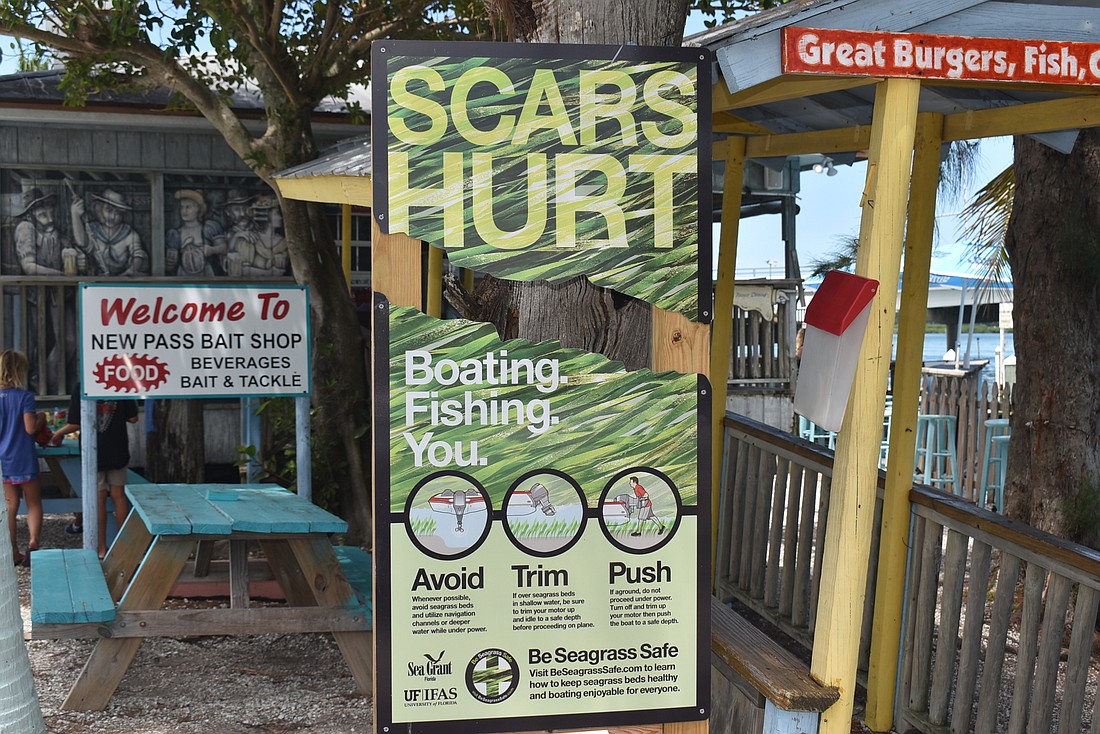- December 21, 2024
-
-
Loading

Loading

With new signs around Longboat Key and the Sarasota-Manatee area, the Sarasota Bay Estuary Program is trying to give Sarasota Bay seagrasses an easier shot at life.
Three new signs at Longboat Key bay accesses catch the eye with the words “SCARS HURT” marred by a scar through the sign. There are eight other matching signs in SBEP’s area. The signs were designed by Florida Sea Grants and have been up since April as part of a campaign to help stop seagrasses from getting ripped up by passing boats.
“They (the signs) kind of have this rip through them to kind of demonstrate what that looks like in the seagrass bed,” Director of Planning and Communications Darcy Young said. “If you're in a kayak just on the bay, you can see these scars. What happens is that rips the seagrasses up basically from their roots, and makes it challenging for them to regrow in that spot.”
Seagrasses are an important habitat for young marine animals, and they also help filter the bay water by trapping particles in their leaves, so keeping boats away is a high priority. Seagrass beds can be damaged by prop scarring, or propeller scarring. A boat with a motor drives through a bed of seagrass, mowing it down and leaving a scar through it.
“We've got over 40,000 registered boats in Sarasota and Manatee counties,” Public Outreach Assistant Christine Quigley said. “That number’s only going to grow, which is great, but we just want to make sure that out-of-town boaters or new boaters are aware that our bay is pretty shallow. It's only about six and a half feet on average … It's more just making people aware that they're there and that they're really important for our economy and important for our natural organisms.”
Prop scarring has been an issue for many years, and Young said research on it started in the late 1980s. New College students did a study on the scars in the early 2000s, and a student picked that up again a couple summers ago to find scar hotspots. Now SBEP is making public outreach part of its efforts with the signs. There's one at the Ken Thompson Parkway boat ramp and another at Cannons Marina.
“We've got them installed at public boat ramps as well as ... as many private boat rental spots as possible,” Young said. “We're trying to do a broad net, because it's not just the people coming in from out of state who don't know the waters. That is a big part of the education, but it can happen to anybody because seagrass beds are ephemeral. They change from year to year. So even if you're somebody who's been boating on the bay for 30, 40, 50 years, there might be seagrass in an area that you didn't expect.”
Running into seagrass can cause extensive damage to a boat’s motor, too, so avoiding it entirely by staying in marked channels and maintaining a safe speed is the best course of action. But Young said if someone gets stuck in a bed, the first thing to do is offload as much weight off the boat as possible before putting up the motor and pushing the boat to a slightly deeper location.
Other than boat interference, seagrasses face danger mostly from water quality. When there are algal blooms, they block the light and the grasses can’t get the light they need to grow. Aside from red tide, nitrogen in the water can cause those harmful blooms.
“Grasses have a lot of stressors and water quality is definitely a huge one, but we also don't want people to forget that physical damage is also a stressor,” Quigley said. “The less stress we can put on them right now, because they're facing a lot of water quality issues, the better.”
Each sign has a holder of Sarasota Bay maps (pictured above) underneath, which Young said a lot of people have taken advantage of. The maps highlight areas where seagrasses are, as well as other points of interest such as restaurants, nature sights and marinas. There’s also information on how to avoid seagrasses and what to do if you’re stuck.
Young said there’s also a survey on the map that they hope people will take so SBEP can see how the program is going. They’re hoping for more interaction on the survey, so make sure to scan the QR code on the map holder.